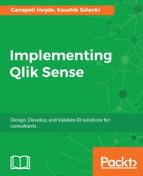Once a solution has been designed and agreed to by the client, the implementation process starts. Implementation has various stages, including the installation of Qlik Sense software, connection to the data sources, data modeling, user interface, validation, and testing. Using the best practices plays an important role in the performance of the software and helps with ease of use. The best practices also improve the flexibility and help increase adoption.
Best practices include writing perfect logic to do incremental data loads. Incremental loads help with faster data refreshes and at same time ease the load on the source systems. If multiple options are available, choose the one which gives better performance; for example, if you have the option of using ODBC or OLEDB, choose OLEDB, as OLEDB gives better performance.
A good approach is to make development as modular as possible. This approach makes the code flexible and easily manageable. The data modeling should be optimized to ensure performance even with an increase in data volumes.
The UI is another critical piece which has a direct impact on how the end user perceives the software. Ensure the Qlik Sense application is neatly categorized and the Dashboarding Analysis and Reporting (DAR) approach is followed. A sheet should be pleasing to the eyes. Too many objects make it difficult for the end users to comprehend.
Aspects like comments in code and brief descriptions of logic shouldn’t be ignored. Validation and test cases should be done thoroughly. Nothing irritates the user more than seeing incorrect data.
